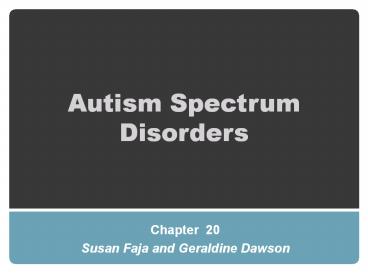Autism Spectrum Disorders - PowerPoint PPT Presentation
1 / 13
Title:
Autism Spectrum Disorders
Description:
TERMINOLOGICAL AND CONCEPTUAL ISSUES. Autism spectrum disorders include autistic disorder, Asperger s disorder, and pervasive developmental disorder not otherwise ... – PowerPoint PPT presentation
Number of Views:157
Avg rating:3.0/5.0
Title: Autism Spectrum Disorders
1
Autism Spectrum Disorders
- Chapter 20
- Susan Faja and Geraldine Dawson
2
HISTORICAL CONTEXT
- Leo Kanner (1943)
- First characterized autism as a variety of
behaviors including lack of social reciprocity
and emotional awareness, delays in communication,
atypical use of language, and repetitive
interests and behaviors. - Hans Asperger (1943)
- Described a high-functioning form of autism that
characterized children as little professors
with intense interests and the ability to provide
lengthy descriptions of their interests.
3
TERMINOLOGICAL AND CONCEPTUAL ISSUES
- Autism spectrum disorders include autistic
disorder, Aspergers disorder, and pervasive
developmental disorder not otherwise specified
(PDD-NOS) - DSM-IV diagnostic criteria include four types of
impairments in each of three domains - Social interaction, communication, and repetitive
or restricted behaviors or interests. - These symptoms typically appear before age 3.
4
TERMINOLOGICAL AND CONCEPTUAL ISSUES
- Comorbidities
- Most commonly, ASD is accompanied by
developmental delay or intellectual disability
however, a significant portion of individuals
with ASD has average to above average
intelligence. - Medical comorbidities, include sleep disorders,
gastrointestinal disorders, psychiatric
conditions, and seizures. - Socioeconomic Considerations
- Affects individuals regardless of socioeconomic
level (Fombonne, 1999, 2003). - Parental education level, continues to be related
to age of diagnosis (Fountain, King, Bearman,
2011). - Diagnosis is also delayed for children in the
Medicaid system (Mandell et al., 2010).
5
PREVALENCE
- ASD affects approximately 1 in 110 children in
the United States (ADDM, 2009) - Annual societal cost of more than 35 billion per
year and approximately 3.2 million per
individual (Ganz, 2007) - Affects males more commonly than females, with a
ratio of 4.5 to 1, and prevalence for boys is 1
in 70 (ADDM, 2009) - Affected females are more likely than males to
have comorbid intellectual disability in the
severe range (IQ lt 35)
6
ETIOLOGICAL FORMULATIONS
Experience-based risk processes in autism
Risk processes
Outcome
Vulnerabilities
Altered neural circuitry Altered patterns of
interaction between child and environment
- Susceptibility genes
- Environmental risk factors
Full autism syndrome Broader autism phenotype
7
GENETICS AND HERITABILITY
- Strong evidence for genetic influences in autism,
yet the role of susceptibility genes is complex. - Multiple genes interact to increase
susceptibility to ASD by influencing gene
expression or encoding functional changes in
proteins that are part of complex regulatory
networks. - The expression and effects of many genes are
influenced by environmental factors, offering
hope that early intervention can alter genetic
expression, brain development, and behavioral
outcomes.
8
ENVIRONMENTAL RISK FACTORS
- Advanced parental age, low birth weight, prenatal
exposure to pollution and pesticides, maternal
infection, and use of certain medications (e.g.,
SSRIs) during pregnancy. - Measles-mumps-rubella (MMR) vaccination
- Epidemiological studies have failed to confirm an
association between the MMR vaccine and autism. - Thimerosal, a preservative containing ethyl
mercury that was added to many vaccines, has also
been examined and no evidence of increased risk
has been found (Parker, Schwartz, Todd,
Pickering, 2004).
9
DEVELOPMENTAL PROGRESSION
- Behavioral Symptoms Apparent in Infancy
- 6 and 12 eye contact declines
- 8 to 10 months infants are less likely to respond
to their name - 6-12 months directed vocalizations (e.g.,
babbling or crying while looking at a person)
decreased and spent longer fixating on a single
object and had less active spontaneous visual
exploration - 12 months there is reduced orienting when called
by name, less time spent looking at faces, and
decreased social interest - 12 to 24 months stereotyped movements and
repetitive behaviors also emerge.
10
DEVELOPMENTAL PROGRESSION
- Toddler-Preschool Period
- Cognitive, language, and behavioral difficulties
- Five key domains of social behavior are affected
- Social orienting
- Joint attention
- Attention to emotional cues
- Motor imitation
- Face processing
11
ABNORMAL NEURAL DEVELOPMENT IN AUTISM
- Structural brain imaging in young children with
autism - 2- to 4-year-olds with ASD have larger total
cerebral volumes. - Neuroimaging of structural and functional
connectivity in children with autism - Differences in white matter (i.e., myelinated
axons) abnormal minicolumn width and cell
numbers, particularly in regions involved in
higher-order behaviors, have led to understanding
the neurobiology of autism as a disorder of
connectivity (Minshew Williams, 2007). - Electrophysiology in young children with autism
- Impairments in brain response in children with
ASD by 6 months for processing eye gaze, and by
age 3 for neural differentiation between the face
of each childs mother and a stranger and slower
processing of emotional content conveyed by
faces.
12
PROTECTIVE FACTORS
- Early comprehensive interventions
- Initiated during the preschool period and
sustained for 2 to 4 years - A significant impact on outcome in a large subset
of children with autism, including significant
gains in IQ, language, and educational placements
(Rogers Vismara, 2008). - Parent-delivered, targeted interventions
- More targeted approach
- Provides training in specific domains for the
caregivers of children with ASD - Interventions for older individuals with ASD
- Used with school-age children
- Group format
- Social skills interventions
13
SYNTHESIS AND FUTURE DIRECTIONS
- Research focused on identifying autism
susceptibility indices, early identification, and
early intervention offer real hope for the
future. - As early identification and intervention become
increasingly effective, the new challenge will be
translating these scientific findings into social
policy.































